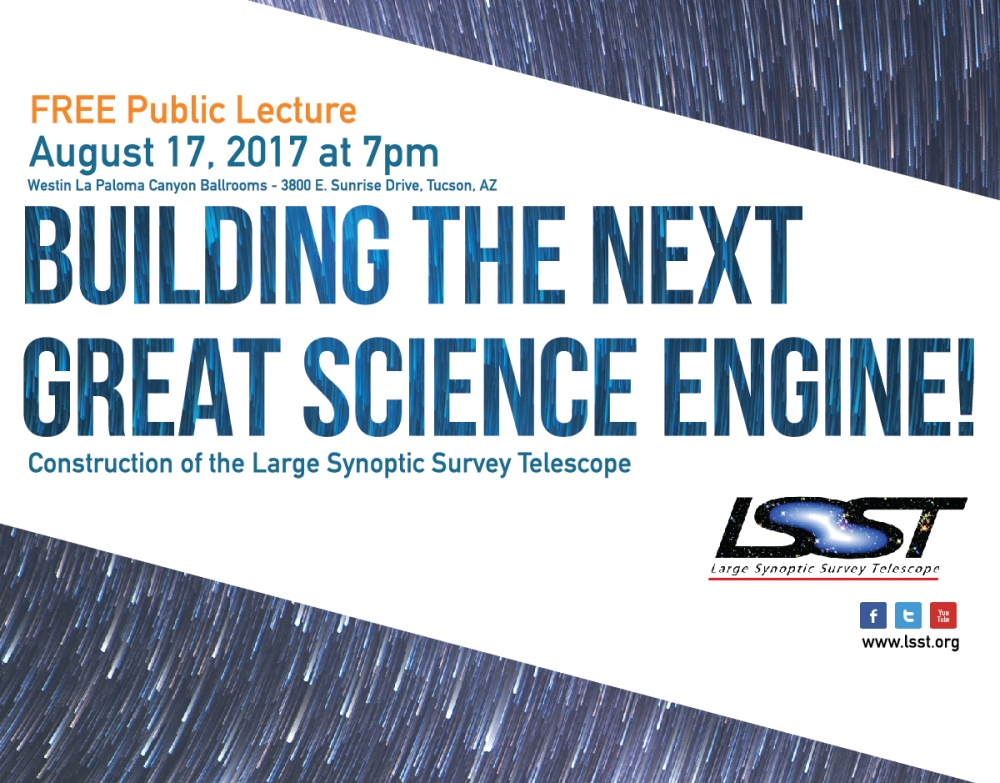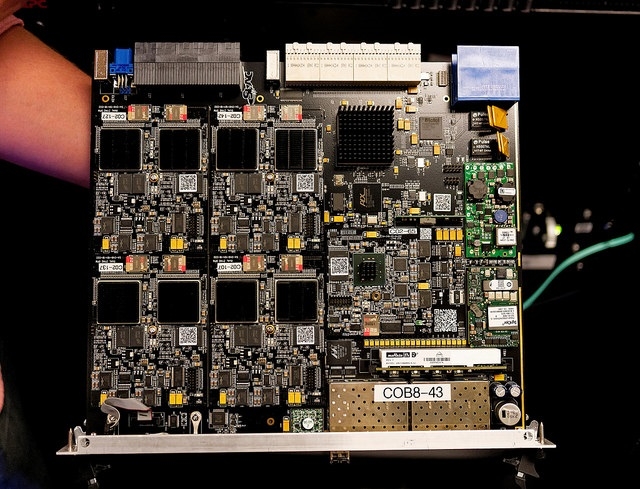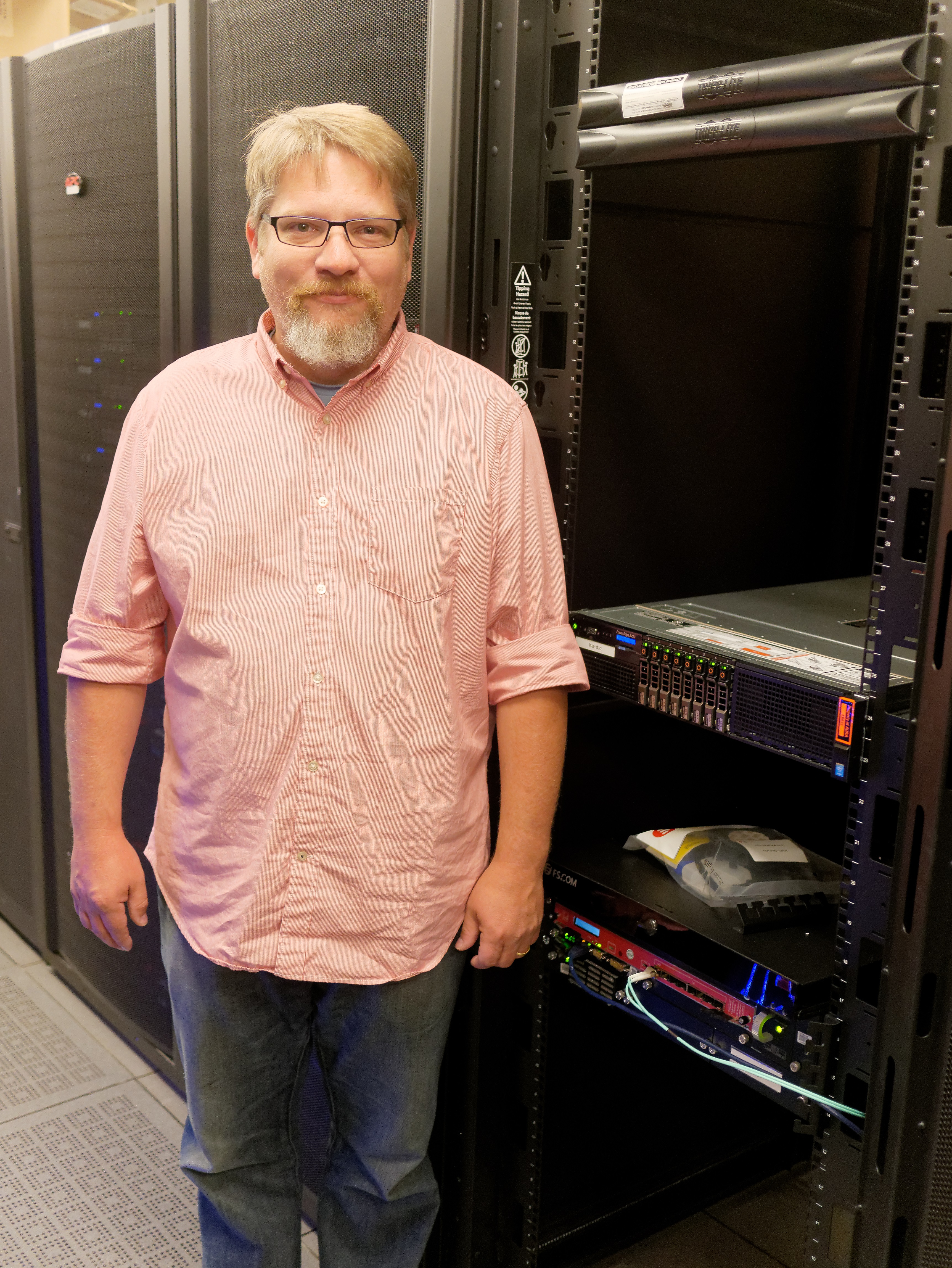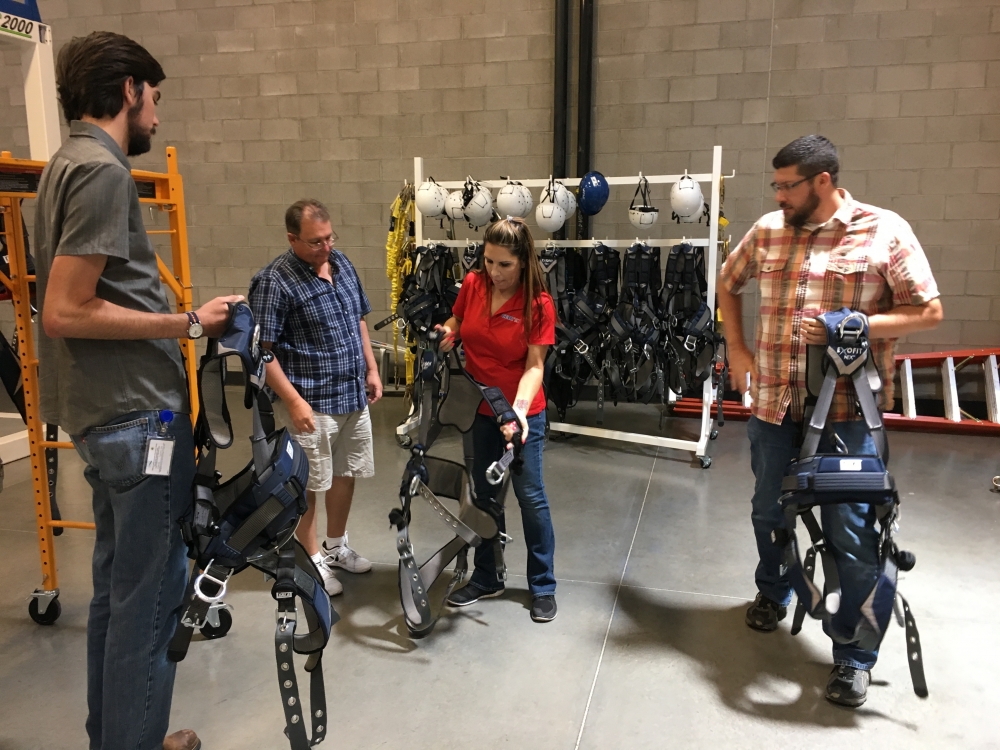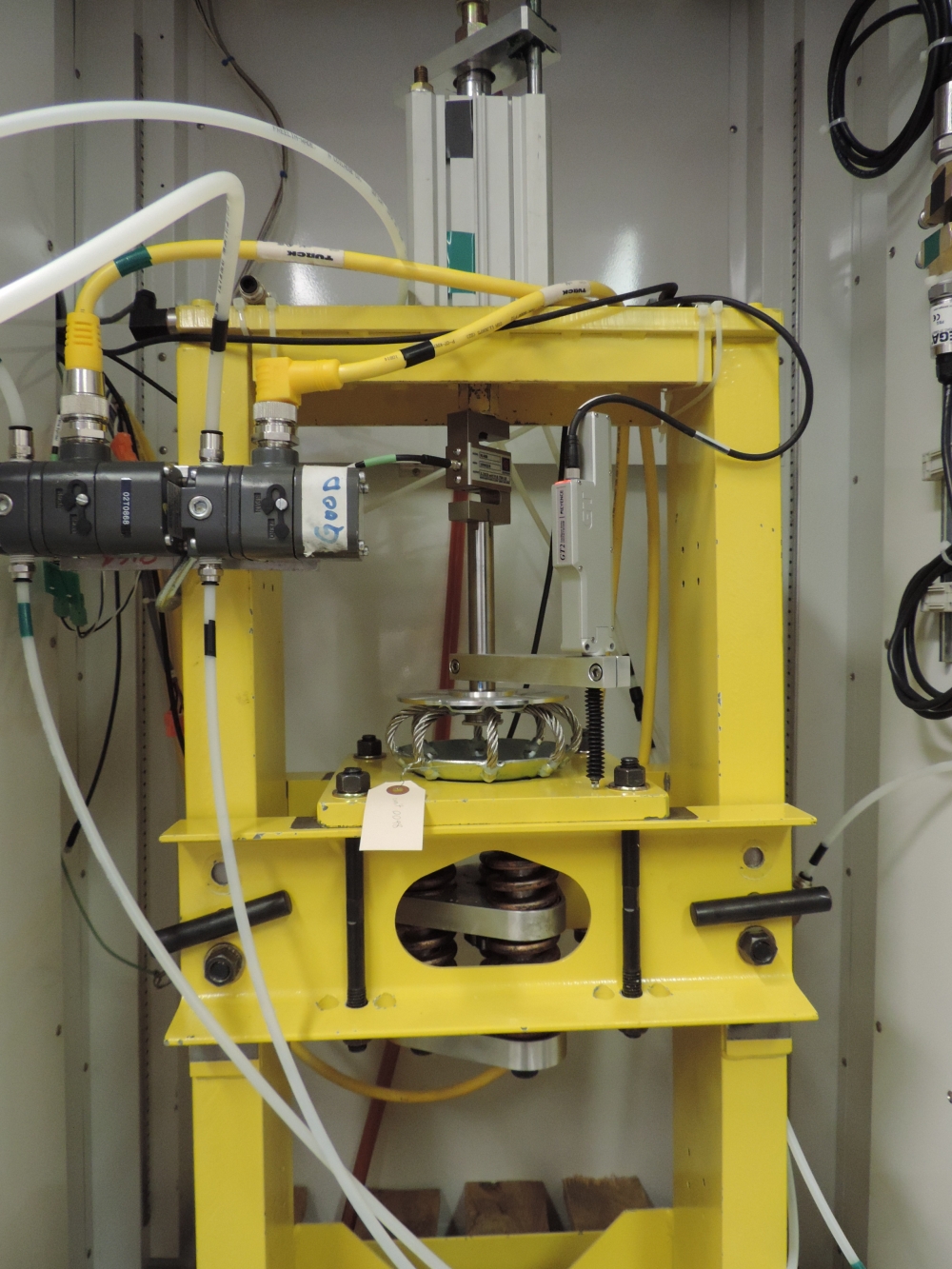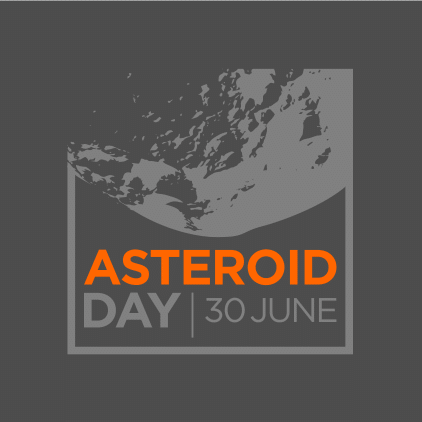Don’t forget to register for the LSST 2017 Project and Community Workshop, which will take place at the Westin La Paloma in Tucson, AZ the week of August 14-18. Although the deadline to suggest a session has passed, we encourage ongoing discussions on the LSST2017 Community Forum. Your ideas and feedback will be valuable as sessions are planned and the Workshop agenda is finalized. Make LSST 2017 YOUR meeting!
The LSST Science Advisory Committee will have a face-to-face meeting the morning of August 14, in coordination with LSST 2017. All attendees to LSST 2017 are welcome to join. Please refer to the published LSST 2017 agenda for the time and location of the meeting.
The LSST Operations Proposal Review meeting took place on June 7-8. This in-person meeting between Red Team reviewers and project leadership enabled productive discussion that will contribute to the overall strengthening of the Proposal.
LSST’s new and improved Gallery website is now live! Photo and video files are now searchable by date, subject, location, and more. Files can be easily downloaded for use according to LSST Media Use Policy. Watch the Gallery for frequent additions of new content; it’s accessible from links on LSST’s Public and Project websites.
On Cerro Pachón, road repairs have been completed to restore full access after a recent series of winter storms. The final batch of concrete has been poured for the lower pier of the Auxiliary Telescope. With the interior steel structure in place and the pre-assembled Ash Dome standing by for installation, the facility for the Auxiliary Telescope is almost complete. At the base facility, demolition of the existing warehouse is underway, making room for the new data center. Webcams for construction activity can be accessed in the LSST Gallery.
The Camera team held an all-hands meeting on June 15. On the agenda was the celebration of two recent major accomplishments resulting from the concerted effort of many individuals. The first, reported in a previous digest, was the completion and acceptance of the first Raft Tower Module (RTM). The second was the completion of the cryostat grid, which will support the camera’s 21 sensor rafts. All components of the cryostat are now at the SLAC National Accelerator Laboratory.
June 30 is Asteroid Day, a day for raising awareness about the potential threat to Earth posed by asteroids. LSST has been recognized as an important tool to identify and track Potentially Hazardous Asteroids (PHAs), and the project will be featured during the 24-hour Asteroid Day Live broadcast on astronomy and asteroid science. LSST was also highlighted in a June 13th GeekWire article as a critical contributor to future asteroid science and planetary defense.
CORPORATION NEWS
The Solar System Science Collaboration (SSSC) launched its new website on June 11, and is currently forming working groups in several areas determined by input from SSSC members. These working groups will provide forums for people with similar specific interests to interact and have more detailed conversations than are possible on the full SSSC listserv. The working group areas are the outer Solar System, the inner Solar System, NEOs (Near Earth Objects), active objects, and community software/infrastructure development.
Getting Ready for Doing Science with LSST Data, an LSSTC-sponsored school and workshop, was held in Lyon, France at the IN2P3 Computing Center this week. Videos of the conference presentations can be found here.
PERSONNEL
Sabine Elles joined the Data Management subsystem as a computing engineer on June 1. Sabine will be involved in the construction of the LSST computing services at the IN2P3 Computing Center.
Michelle Butler joined the Data Management subsystem as Senior Technical Program Manager on June 1. Michelle will be coordinating LSST activities for the groups in NCSA’s Integrated Cyberinfrastructure Directorate, including system administration, networking, storage, and databases.
Luis Corral joined the LSST IT group on June 19th as a Network Engineer located in Chile. Luis comes to LSST from European Southern Observatory (ESO); he will be working on the installation of the LSST summit networking system along with the computer room equipment.
UPCOMING MEETINGS with LSST INVOLVEMENT
(those with asterisk* are LSSTC funded):
2017
|
|
|
June 19 – 21
|
AURA Workforce and Diversity Committee (WDC), Maui, HI
|
|
June 25-30
|
Adaptive Optics for Extremely Large Telescopes (AO4ELT5) Meeting, Canary Islands, Spain
|
|
July 10 - 14
|
DESC Meeting, Dark Energy School, and Hack Day*, jointly hosted by Stony Brook University & BNL
|
|
July 14
|
The Photometric LSST Astronomical Time-series Classification Challenge (PLAsTiCC)*, Flatiron Institute, NY (additional dates/locations TBA in locations throughout North America and the UK)
|
|
July 25-27
|
NSF/DOE Joint Status Review of Data Management, NCSA, IL
|
|
August 14 – 18
|
LSST 2017 Project & Community Workshop, Tucson, AZ
|
|
September 6 – 8
|
NSF/DOE Joint Status Review, Tucson, AZ
|
|
September 14 – 15
|
AURA Management Council for LSST (AMCL) Meeting, Tucson, AZ
|
|
September 26-28
|
Education and Public Outreach (EPO) subsystem review, Tucson, AZ
|
|
October 22-26
|
Astronomical Data Analysis Software and Systems (ADASS) Conference, Santiago, Chile
|
|
October 26-28
|
Society of Women Engineers WE17 Conference, Austin, TX
|
|
November 7 – 9
|
AURA Workforce & Diversity Committee (WDC), La Serena, Chile
|
Noticias del Proyecto
No te olvides que registrarte register para el Taller de Proyecto y Comunitario LSST 2017, que tendrá lugar en el Westin La Paloma Tucson, AZ la semana del 14 al 18 de agosto. Aunque la fecha límite para proponer una sesión ha pasado, alentamos a los debates en curso en el LSST2017 Community Forum. Tus ideas y comentarios serán valiosos a medida que las sesiones son planificadas y el programa del Taller sea finalizado. Hace LSST 2017 tu reunión!
El LSST Science Advisory Committee tendrá una reunión cara-a-cara en la mañana del 14 de agosto, en coordinación con LSST 2017. Todos los asistentes a LSST 2017 son bienvenidos a unirse. Consulte la agenda LSST 2017 publicada para ver la hora y el lugar de la reunión.
La Revisión de la Propuesta de Operaciones de LSST tomó lugar en junio 7-8. Esta reunión en persona entre el Equipo Rojo de Revisores y el liderazgo del proyecto permitió un debate productivo que contribuirá al fortalecimiento general de la Propuesta.
La nueva y mejorada Galeria del sitio web está en vivo! Archivos de fotos y vídeos se pueden buscar por fecha, asunto, ubicación y más. Los archivos pueden descargarse fácilmente para uso según la Política de Uso de Medios de LSST Media Use Policy. Está atento a la galería para ver adiciones frecuentes de contenido nuevo, la cual es accesible desde los enlaces del sitio web Público y del Proyecto Public & Project de LSST.
En Cerro Pachón, la reparación de los caminos se ha completado para restaurar el acceso completo después de una reciente serie de tormentas invernales. El último lote de cemento ha sido vertido en el lower pier del Telescopio Auxiliar Auxiliary Telescope. Con la estructura de acero en el interior en su lugar y pre-ensamblada, Ash Dome esta en stand-by para la instalación, el telescopio auxiliar está casi completo. En las instalaciones base, la demolición de la bodega actual está en marcha, haciendo espacio para el nuevo centro de datos. La webcam de la actividad de la construcción se puede acceder a través de la Galería de LSST Gallery.
El equipo de la Cámara tuvo una reunión el 15 de junio. En la programación estaba la celebración de dos importantes logros recientes resultantes del esfuerzo concertado de muchas personas. El primero, informado en noticias previas previous digest, fue la finalización y aceptación de la primera Raft Tower Module (RTM). El segundo fue la finalización de la cuadrícula de criostato, que prestará apoyo a los 21 sensores rafts de la cámara. Todos los componentes del criostato están ahora en el Laboratorio del Acelerador Nacional SLAC.
El 30 de junio es el Día del Asteroide, un día para concienciar sobre la amenaza potencial que plantean a la Tierra los asteroides. LSST ha sido reconocido como una importante herramienta para identificar y realizar el seguimiento de los Asteroides Potencialmente Peligrosos (PHA), y el proyecto será presentado durante la transmisión de 24-hour Asteroid Day Live de astronomía y la ciencia de asteroides. LSST también fue destacado en el artículo del 13 de junio GeekWire article como un contribuyente decisivo a la ciencia de asteroides y defensa planetaria a futuro.
Noticias de la Corporación
La Colaboración de la Ciencia del Sistema Solar (SSSC) lanzó su nuevo sitio web website el 11 de junio, y actualmente está formando grupos de trabajo en varios ámbitos determinados por la entrada de miembros a la SSSC. Estos grupos de trabajo proporcionaran foros para personas con los mismos intereses específicos para interactuar y mantener conversaciones más detalladas que son posibles en todo el listserv de SSSC. Las áreas del grupo de trabajo son el Sistema Solar exterior, el interior del Sistema Solar, Objetos Cercanos a la Tierra (Near Earth Objects), objetos activos, y la comunidad de software/desarrollo de la infraestructura.
Getting Ready for Doing Science with LSST Data, Preparándonos para Hacer Ciencia con Datos de LSST, Una escuela y taller patrocinado por LSSTC, tomó lugar en Lyon, Francia, en el Centro de Computación IN2P3 esta semana. Videos de las presentaciones de la conferencia pueden ser encontrados aquí here.
Personal
Sabine Elles se unió al subsistema de Gestión de Datos como Ingeniero Informático el 1 de junio. Sabine estará involucrada en la construcción de servicios informáticos de LSST en el Centro de Computación IN2P3.
Michelle Butler se unió al subsistema de Gestión de Datos como Gerente Senior Técnico de Programas el 1 de junio. Michelle coordinara las actividades de LSST en el Integrated Cyberinfrastructure Directorate del grupo en NCSA, incluyendo la administración del sistema, redes, almacenamiento y bases de datos.
Luis Corral se unió al grupo de Informática de LSST el 19 de junio como Ingeniero de Redes ubicado en Chile. Luis llega a LSST del Observatorio Europeo Austral (ESO); él estará trabajando en la instalación del sistema de redes en el sitio de LSST junto con los equipos de la sala de informática.
Próximas reuniones con participación LSST
(aquellos con un asterisco* son financiados por LSSTC):
2017
|
|
|
Junio 19-21
|
Fuerza Laboral de AURA & Comité de Diversidad (WDC), Maui, HI
|
|
Junio 25-30
|
Reunion de Adaptive Optics for Extremely Large Telescopes (AO4ELT5), Islas Canarias, España
|
|
Julio 10-14
|
DESC Meeting, Dark Energy School, and Hack Day*, organizado en conjunto con Stony Brook University y BNL
|
|
Julio 14
|
The Photometric LSST Astronomical Time-series Classification Challenge (PLAsTiCC)*, Instituto Flatiron, NY (fechas/ubicaciones adicionales por anunciar en ubicaciones a través de Norte América y el Reino Unido)
|
|
Julio 25-27
|
Revisión de Estado Conjunto para Gestión de Datos NSF/DOE, NCSA, IL
|
|
Agosto 14-18
|
Taller de Proyecto & Comunidad LSST 2017, Tucson, AZ
|
|
Septiembre 6-8
|
Revisión de Estado Conjunta NSF/DOE, Tucson, AZ
|
|
Septiembre 14-15
|
Reunión Consejo de Gestión de AURA para LSST (AMCL), Tucson, AZ
|
|
Octubre 22-26
|
Conferencia Astronomical Data Analysis Software and Systems (ADASS), Santiago, Chile
|
|
Octubre 26-28
|
Conferencia Sociedad de Mujeres Ingenieros WE17, Austin, TX,
|
|
Noviembre 7 – 9
|
Fuerza Laboral de AURA & Comité de Diversidad (WDC), La Serena, Chile
|


